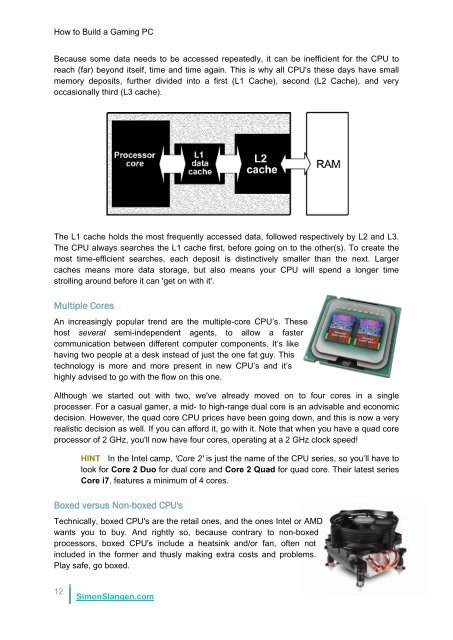Build a Gaming PC.pdf
Build a Gaming PC.pdf
Build a Gaming PC.pdf
Create successful ePaper yourself
Turn your PDF publications into a flip-book with our unique Google optimized e-Paper software.
How to <strong>Build</strong> a <strong>Gaming</strong> <strong>PC</strong><br />
Because some data needs to be accessed repeatedly, it can be inefficient for the CPU to<br />
reach (far) beyond itself, time and time again. This is why all CPU's these days have small<br />
memory deposits, further divided into a first (L1 Cache), second (L2 Cache), and very<br />
occasionally third (L3 cache).<br />
The L1 cache holds the most frequently accessed data, followed respectively by L2 and L3.<br />
The CPU always searches the L1 cache first, before going on to the other(s). To create the<br />
most time-efficient searches, each deposit is distinctively smaller than the next. Larger<br />
caches means more data storage, but also means your CPU will spend a longer time<br />
strolling around before it can 'get on with it'.<br />
Multiple Cores<br />
An increasingly popular trend are the multiple-core CPU’s. These<br />
host several semi-independent agents, to allow a faster<br />
communication between different computer components. It’s like<br />
having two people at a desk instead of just the one fat guy. This<br />
technology is more and more present in new CPU’s and it’s<br />
highly advised to go with the flow on this one.<br />
Although we started out with two, we've already moved on to four cores in a single<br />
processer. For a casual gamer, a mid- to high-range dual core is an advisable and economic<br />
decision. However, the quad core CPU prices have been going down, and this is now a very<br />
realistic decision as well. If you can afford it, go with it. Note that when you have a quad core<br />
processor of 2 GHz, you'll now have four cores, operating at a 2 GHz clock speed!<br />
HINT In the Intel camp, 'Core 2' is just the name of the CPU series, so you’ll have to<br />
look for Core 2 Duo for dual core and Core 2 Quad for quad core. Their latest series<br />
Core i7, features a minimum of 4 cores.<br />
Boxed versus Non-boxed CPU's<br />
Technically, boxed CPU's are the retail ones, and the ones Intel or AMD<br />
wants you to buy. And rightly so, because contrary to non-boxed<br />
processors, boxed CPU's include a heatsink and/or fan, often not<br />
included in the former and thusly making extra costs and problems.<br />
Play safe, go boxed.<br />
12<br />
SimonSlangen.com

















